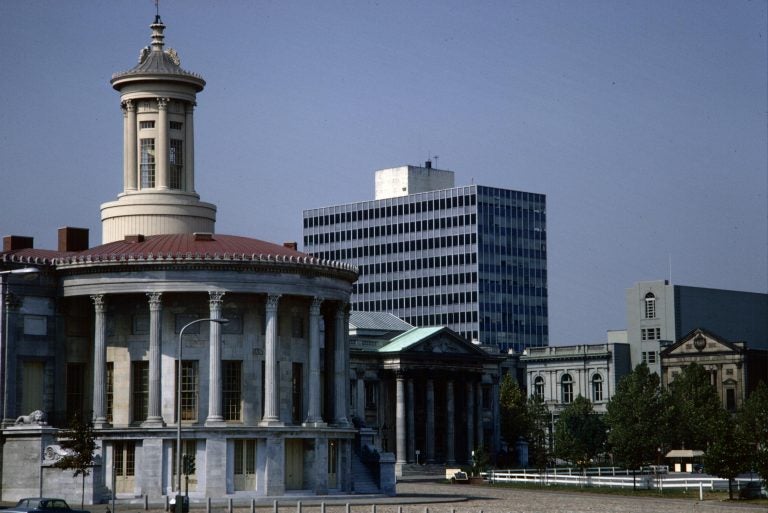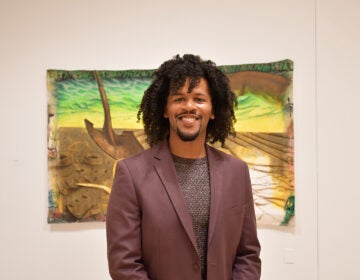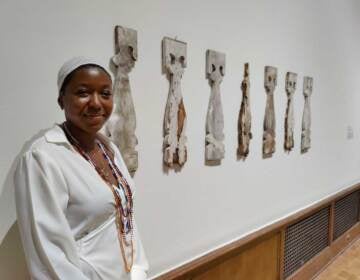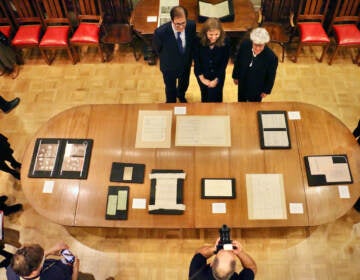Hive mind: What’s in these Ed Bacon photos?
Five thousand pictures of Philly in the 1960s and '70s were donated to Penn, without descriptions. The university is asking the internet for help.

Before he died in 2005, Philadelphia city planner Edmund Bacon donated hundreds of photos to the Fisher Fine Arts Library. The photos arrived without identification, so now the library is making the collection available to the public via Flickr hoping that crowdsourcing will provide the answers. (Fisher Fine Arts Library)
Ed Bacon, the legendary urban planner who shaped Center City Philadelphia in the mid-20th century (in addition to being the father of movie star Kevin Bacon), donated more than 5,000 photographs to the University of Pennsylvania before he died in 2005.
The trove of color images – many of them seemed to be taken with an amateur, consumer-grade camera — feature the buildings, streets, and people of Philadelphia in the 1960s and 1970s, as well as city views of other cities around the world.
The problem is, Bacon didn’t label any of them.
“There was some record, you can see here it’s chicken scrawl,” said Hannah Bennett, the director of the Fisher Fine Arts Library at the University of Pennsylvania, holding a photocopied stack of handwritten logs with the barest of descriptions and no indication for which image corresponds to which description.
“There are images from all over the world. Egypt. Australia. Paris,” she said. “But the bulk of it is Philadelphia, as best we can figure out.”
There are pictures of the old Horn and Hardart automat diner that used to be across the street from City Hall, fronted by a small sculpture garden in a brick plaza. These things no longer exist.
Bacon seemed to be taking pictures of how people use public spaces. There are unidentified people splashing in a fountain. There is what appears to be a family taking a breather on a bench on Independence Mall (the bench is no longer there).
There is a series of images of the same, small backyard of a rowhome, ringed with a chain link fence, buried in about two feet of snow. There are images of Society Hill as it was being redeveloped as an 18th-century architectural enclave. There’s a picture of a man smoking on a street corner, perhaps in Cairo.
There are pictures of building models, city maps, and unknown graphic designs that may be related to city planning but without any context they instead resemble mid-century Pop abstraction.
“There are some surprises,” said Bennett. “The models have to be related to his work for the city. But others – like his shots of Egypt – are, like: Huh?”
Bennett is overseeing an effort to put the images online to the photo-sharing platform Flickr, in order to solicit feedback from the public, if anybody recognizes anything.
“You want to know what’s in the photograph, ideally a date, ideally a style of building – a pagoda, a skyscraper,” said Bennett. “You want to identify the images as best you can so when someone goes to a database to search for Philadelphia architecture, the right image comes up.”
Some of the images are obvious, like a series of pictures of the Swann Memorial Fountain on the Benjamin Franklin Parkway. But they, too, hold secrets: who is that man dressed in white at the center of each picture?
“The ones of Vietnam are really interesting. A lot were taken before the war. So, like, Saigon, now Ho Chi Minh City, looks a lot different then than they do now. It’s really interesting,” she said. “You don’t’ have to be a Bacon scholar – or a Bacon enthusiast – to enjoy these pictures.”
The effort already is seeing results. Bennett said in just the first several days the Flickr page for the Ed Bacon Photo Project had garnered thousands of followers, and several hundred email comments, “from Boston to Berkeley.”
Some of the comments are useful, others less so. Posting the photos on the internet potentially exposes Bennett and the Fisher Library to the nefarious elements. In order to discourage illegal appropriation, Bennett had the images uploaded in a lower resolution.
At the end of the day, it’s worth it.
WHYY is your source for fact-based, in-depth journalism and information. As a nonprofit organization, we rely on financial support from readers like you. Please give today.





